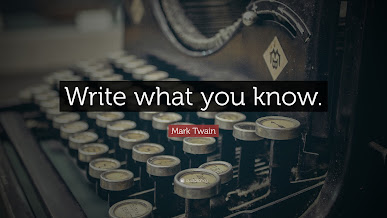WRITE WHAT YOU KNOW
Mark Twain once said, “Write what you know.” It is one of the first things a writer will learn when they start out. When I first heard this common refrain, I thought, “That feels limiting.” I wanted to learn and write about things I didn’t know. Yet, over time, I have discovered that who I am, what I believe and what I love tends to end up in the pages of my books, without my even thinking about it.
THE WOMAN’S JOURNEY
When I wrote my first book, River of the Stick Wavers, I really had
no idea what it was about until after I’d finished it. I knew I was writing
about a woman who had lost her husband and was questioning who she was without him.
But at a deeper level, I realized I was writing about the woman's journey. It then
became clear to me that this is something that is important to me. I came to
realize that by writing about how women work through their struggles from a
woman’s perspective, I could perhaps make a difference in other women’s lives
by showing them that they are not alone, and perhaps even inspire them to a
deeper understanding of themselves.
DEFINING SUCCESS
In my new book Gift of the Loon I knew the message I
wanted to share. “What does success look like, and how do we measure it?” Of
course, this was a topic that I was dealing with myself at the time. I was
struggling with how to define my own success as a writer. Therefore, it seemed like a
natural progression for me to write about it to help me understand it through
the eyes of my protagonist, Margaret Harrison, who was struggling to find a place
for herself in the art world of 1900s Toronto.
LESSONS IN ART
Within this story, I was able to explore something else I love – art. I
took lessons so I would be able to write convincingly about what an artist
experiences when they work with paints, brushes, and a palette knife. I learned
to mix colors and experimented with different techniques to express myself on
the canvas. This experience enabled me to write not only about what an artist
does with their hands, but what is going on inside their head, bringing my
story to life.
CANOEING AND HIKING
My love of canoeing and hiking also ended up in the pages of Gift of the
Loon. I was able to accurately describe not only how to handle a canoe, but how
the water feels beneath the pull of the paddle. I was able to bring to life the
method of travel in a watery landscape without benefit of signposts.
My experience with hiking enabled me to write with authority when my
protagonist, Maggie, spends a few weeks in Algonquin Park painting with artist, Tom
Thomson. The inherent danger and exhilaration involved in being out in wild
Canadian landscape.
FAMILIAR LANDSCAPES
My first two books are both set in Ontario, Canada - my adopted country
- a place both familiar and beloved. I’ve often felt that there are not enough
books set in Canada. Then my next book took me completely by surprise by
wanting to be set in the Lake District of England, the place of my birth. Not
unfamiliar, and still a part of me. It is a place I’ve longed to explore ever
since I stayed there briefly in the 1997. To that end, I plan to visit the Lake
District later this year and walk the landscape to get a feel for it, so I am
better able to bring it to life for my reader.
WHAT I KNOW
As you can see, much of what I know has turned up in the pages of my books. It’s only natural that I’d want to write about something that interests me. To explore its intricacies and hopefully gain a deeper understanding of myself, and in turn, offer it up to the reader for closer examination so that they can perhaps have a better understanding of themselves as well.

.jpg)

Comments
Post a Comment